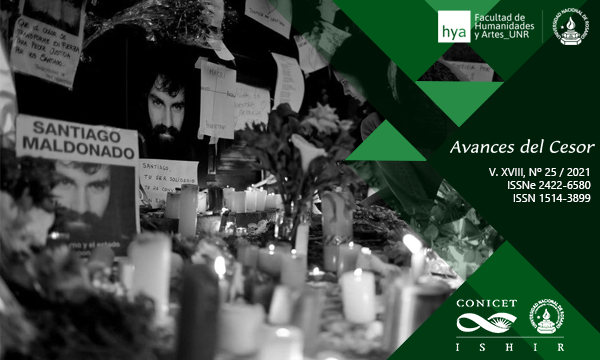Writing Eva’s Death: Obituaries and Popular Memories in Argentina
DOI:
https://doi.org/10.35305/ac.v18i25.1533Keywords:
written death, emotions, popular memories, Peronism, ArgentinaAbstract
The article focusses on the analysis of condolence letters, poetry and musical compositions that men and women sent to President Juan Domingo Perón regarding the death of his wife Eva in 1952. It dives into the very diverse languages, objects and situations that structured the writing, as well as the emotions associated with the loss. Through the letters, an attempt was made to communicate and put in order the experiences of pain; to narrate the feelings of the people as an expression of the prolific political bond between the mourners and Peronism; or even to propose how to remember Eva and who should keep the political and emotional heritage posed by her disappearance. The corpus of letters provides a unique opportunity to explore the ways in wich some men and women tried to make sense of a crucial historical event in their lives in particular, for Peronism in general, and for Argentine politics beyond the ritual as it was planned and controlled by the State.
Downloads
References
Acha, O. (2007). Cartas de amor en la Argentina peronista: construcciones epistolares del sí mismo, del sentimiento y del lazo político populista. Nuevo Mundo Mundos Nuevos, 8.
Adamovsky, E. (2019). El gaucho indómito. De Martín Fierro a Perón, el emblema imposible de una nación desgarrada. Buenos Aires: Siglo XXI.
Ahmed, S. (2004). The Cultural Politics of Emotion. Edinburg: Edinburgh University Press and Routledge.
Ballent, A. (2005). Las huellas de la política. Vivienda, ciudad, peronismo en Buenos Aires, 1943-1955. Buenos Aires: Prometeo y Universidad Nacional de Quilmes.
Boddice, R. (Dir.). (2014). Pain and Emotion in Modern History. London: Palgrave McMillan.
Bourke, J. (2014). Pain: metaphor, body, and culture in Anglo-American societies between the eighteenth and twentieth centuries. Rethinking History: The Journal of Theory and Practice, 18(4), 475-498.
Caimari, L. (1995). Perón y la Iglesia Católica. Religión, Estado y sociedad en la Argentina (1943-1955). Buenos Aires: Ariel.
Casas, M. E. (2017). La Metamorfosis el gaucho. Círculos criollos, tradicionalistas y política en la provincia de Buenos Aires 1930-1960. Buenos Aires: Prometeo.
Collado, A. (2013). Arquitectura moderna para el servicio postal – Argentina, 1947-1955. En A. Collado (Ed.), Arquitectura moderna y estado en Argentina: edificios para correos y telecomunicaciones (1947-1955), pp.29-54. Buenos Aires: Centro de Documentación de Arte y Arquitectura Latinoamericana (CEDODAL), Facultad de Arquitectura, Diseño y Urbanismo de la Universidad Nacional del Litoral (UNL).
Comastri, H. (2020). Productividad y política obrera desde las bases: la imaginación técnica popular en las cartas a Perón (1946- 1955). Quinto Sol, 24(1).
Dauphin, C. (2002). Les correspondances comme objet historique. Un travail sur les límites. Sociétés et Représentations, 1(13), 43-50.
Dixon, T. (2015). Weeping Britannia: Portrait of a Nation in Tears. Oxford: Oxford University Press.
Elena, E. (2005). What the People Want: State Planning and Political Participation in Peronist Argentina, 1946- 1955. Journal of Latin American Studies, 37(1), 81-108.
Elias, N. (1987). La soledad de los moribundos. México: FCE.
Ehrick, C. (2015). Radio and the Gendered Soundscape. Women and Broadcasting in Argentina and Uruguay 1930-1950. New York: Cambridge University Press.
Fitzpatrick, S. (1996). Supplicants and Citizens: Public Letter-Writing in Soviet Russia in the 1930s. Slavic Review, 55(1), 79.
Gayol, S. (2020). La otra cara de la felicidad: dolor y martirio en el peronismo clásico. Anuario del Instituto de Historia Argentina, 20(1), e110. https://doi.org/10.24215/2314257Xe110.
Gayol, S. (2021). La muerte al instante: telegramas y notas de pésame en la Argentina peronista. Trashumante. Revista Americana de Historia Social, 18, 168-189.
DOI: 10.17533/udea.trahs.n18a08
Gutiérrez, F. (en prensa). Vivir en un pueblo azucarero: entre el asistencialismo empresarial y el derecho al bienestar Tucumán durante el primer peronismo. En Mirta Zaida Lobato (Ed.), Comunidades, historia local e historia de pueblos. Huellas de su formación. Buenos Aires: Prometeo.
Guy, D. (2016). Greating Charismatic Bonds in Argentina. Letters to Juan and Eva Perón. Alburquerque: University of New Mexico.
Hochschild, A. R. (1979). Emotion Work, Feeling Rules, and Social Structure. American Journal of Sociology, 85, 551-575.
Labanyi, J. (2010). Doing Things: Emotion, Affect and Materiality. Journal of Spanish Cultural Studies, 1(3,4), 223-233.
Leclerc-Olive, M. (2008). Des événements en souffrance : de Mead à Benjamin. Quelques considérations épistémologiques. Cahiers d’anthropologie sociale, 1(1), 43-62.
Mauss M. (1921). L'expression obligatoire des sentiments (rituels oraux funéraires australiens). Journal de psychologie, 18.
Milic, E. (2014). Artefacts as Mediators through Time and Space: 159 The Reproduction of Roots in the Diaspora of Lussignani. En Maruška Svašek (Ed), Moving Subjects, Moving Objects Transnationalism, Cultural Production and Emotions (pp. 159-177). New York: Berghahn Books.
Miller, D. (1987). Material Culture and Mass Consumption. Nueva York: Wiley Blackwell.
Morris, D. (1993). La cultura del dolor. Santiago de Chile: Andrés Bello.
Navarro, M. M. (1997). Evita. Buenos Aires: Planeta.
Peluffo, A. (2013). Gauchos que lloran: masculinidades sentimentales en el imaginario criollista. Cuadernos de literatura, XVII(33), 187-201.
Petrucci, A. (1998). Writing the dead. Death and Writing Strategies in the Western Tradition. California: Stanford University Press.
Plotkin, M. (1993). Mañana es San Perón. Buenos Aires: Ariel.
Poderti, A. (2010). Diccionario del peronismo. Buenos Aires: Biblos.
Santos Lepera, L. (2012). Las manifestaciones colectivas de duelo frente a la muerte de Eva Perón (Tucumán, 1952). Boletín Americanista, XII.1(64), 161-180.
Rosaldo, R. (1991). Cultura y verdad. Nueva propuesta de análisis social. México: Grijalbo.
Sarlo, B. (2003). La Pasión y la excepción. Buenos Aires: Siglo XXI.
Scheer, M. (2012). Are emotions a kind of practice (and is that what makes them have a history)? A bourdieuian approach to understanding emotion. History and Theory, 51(2), 193-220.
Slaby, J. (2020). Political emotions. En T. Szanto, and H. Landweer (Eds.), The Routledge Handbook of Phenomenology of Emotions (pp. 3-4). London, New York: Routledge.
Torre, J. C. y Pastoriza E. (2002). La democratización del bienestar. En J. C. Torre (Ed.), Nueva Historia Argentina. Los Años Peronistas (1943-1955) (pp. 259-310). Buenos Aires: Sudamericana.
Wailoo, K. (2014). Pain: A Political History. Baltimore: John Hopkins University Press.
Zanatta, L. (2011). Eva Perón. Una biografía política. Buenos Aires: Sudamericana.
Published
How to Cite
Issue
Section
License

This work is licensed under a Creative Commons Attribution 4.0 International License.
Avances del CESOR ratifies the Open Access model in which the contents of scientific publications are fully available for free on the Internet, without temporary embargoes, and whose publishing costs are not transferred to the authors. This policy aims to break the economic barriers that generate inequities in access to information, and publication of research results.
Authors retain the copyrights of their papers and grant the journal right of first publication with the work simultaneously licensed under a Creative Commons that allows others to share the work with an acknowledgement of the work's authorship and initial publication in this journal.



















































